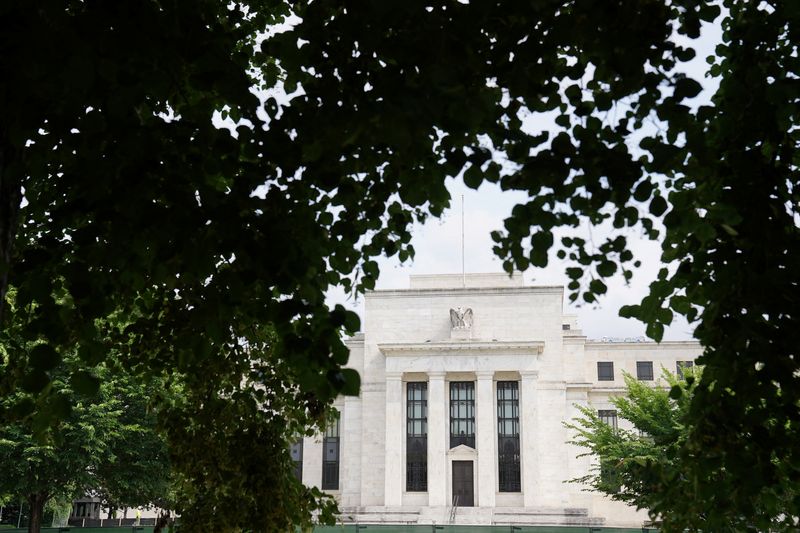
© Reuters
By Noreen Burke
Investing.com — The world’s top central banks are set to wrap up 2022 with hefty rate hikes as their battle against inflation continues. With expectations for a half-point hike from the Federal Reserve at Wednesday’s meeting already baked in investors will instead be focusing on indications of how high rates may ultimately rise. U.S. inflation data on Tuesday will provide fresh clues on the Fed’s plans. The double whammy of inflation data and the Fed meeting will likely set the tone for U.S. stocks for the rest of the year and beyond. Meanwhile, the Bank of England and the European Central Bank are expected to deliver half-point rate hikes when they meet on Thursday. Here’s what you need to know to start your week.
- Fed meeting
point to a 78% chance the Fed will raise by 50 basis points on Wednesday, with a 21% chance of a 75-basis point hike, with those odds little changed after data on Friday showing that rose slightly more than expected last month.
The U.S. central bank has raised interest rates by 375 basis points this year, including four consecutive 75 basis point hikes, in the fastest rate-hiking cycle since the 1980s, to combat soaring inflation.
Fed Chair Jerome Powell will hold his last news conference of the year after recently indicating that it could be time to slow the pace of rate increases.
While the Fed has indicated that the pace of increases is likely to slow, interest rates are likely to end up at a higher level than officials indicated was likely back in September, so focus may turn to signals for how high rates may ultimately raise in 2023.
- U.S. CPI
The U.S. is to release consumer price inflations data for November on Tuesday, with economists expecting the annual rate of inflation to slow to from 7.7% the previous month.
The recent strong U.S. jobs data rekindled inflation fears, after wage growth accelerated in November.
Data on Friday showed that rose slightly more than expected last month amid a jump in the costs of services, but the underlying trend is moderating as supply chains ease and demand for goods ebbs.
“While core goods prices in CPI are still very likely to decline in November given falling used car prices, a renewed increase in core goods PPI highlights that there remain some underappreciated upside risks to goods prices into next year,” Veronica Clark, an economist at Citigroup in New York told Reuters.
- U.S. stocks
Stock markets will be braced for the double dose of CPI data and the Fed decision that will set the direction for markets for the remainder of this year and into 2023.
The ’s latest rebound stalled in the past week, as stronger-than-expected PPI data fueled concerns that the Fed will need to keep interest rates higher for longer, potentially leading to a recession.
Hotter-than-expected CPI could bolster fears of more Fed hawkishness, pressuring stocks.
“If CPI comes in north of expectations or even doesn’t decline at all, that is not going to be market-positive,” Tom Hainlin, national investment strategist at U.S. Bank Wealth Management told Reuters.
With Wednesday’s rate hike largely seen as a foregone conclusion, Wall Street will be focused on the Fed projections for how high rates will ultimately rise.
Also key will be Powell’s views on inflation and the possibility that the economy can slip into recession next year – an idea that has dominated market sentiment this year.
- Bank of England
A deteriorating economic outlook is unlikely to stop the hiking rates by 50 basis points to 3.5%, which would be the highest since 2008, when it meets on Thursday.
The U.K. is to release data for November on Wednesday which may show that inflation has peaked after hitting a 41-year high of 11.1% in October, more than five times the BoE’s 2% target.
Much of the increase has been driven by the energy price shock resulting from Russia’s war in Ukraine, but other factors such as labor shortages caused by Brexit and the COVID-19 pandemic could make inflation slow to fall.
Britain’s economy is heading into a recession and households are facing a historic squeeze on living standards after the government introduced a tough budget to try to restore Britain’s fiscal reputation.
- ECB
Market watchers are expecting the to deliver a 50-basis point rate hike when it meets on Thursday after data last month showing that annual inflation slowed for the first time in one-and-a-half years, ticking down to from 10.6% in October.
The ECB has raised rates by 200 basis points since July, its fastest pace on record, but inflation remains well above its 2% target.
While a slowdown in the pace of rate increases may be coming, the ECB is far from done and markets will be looking for clues on where the key 1.5% deposit rate will end up.
“They (policymakers) will keep sounding hawkish and aggressive as they want inflation expectations to remain anchored,” Frederik Ducrozet, head of macroeconomic research at Pictet Wealth Management told Reuters.
–Reuters contributed to this report





